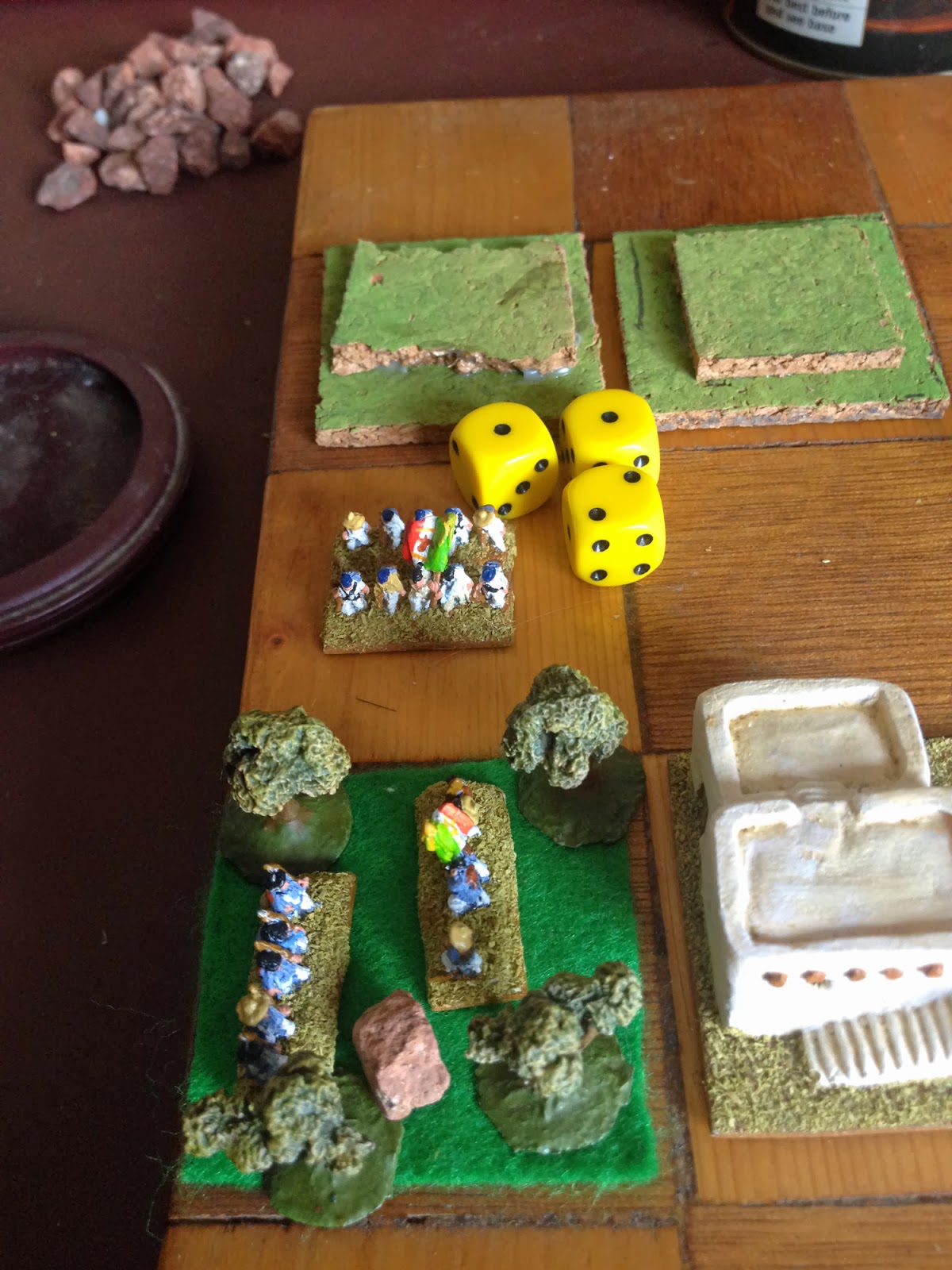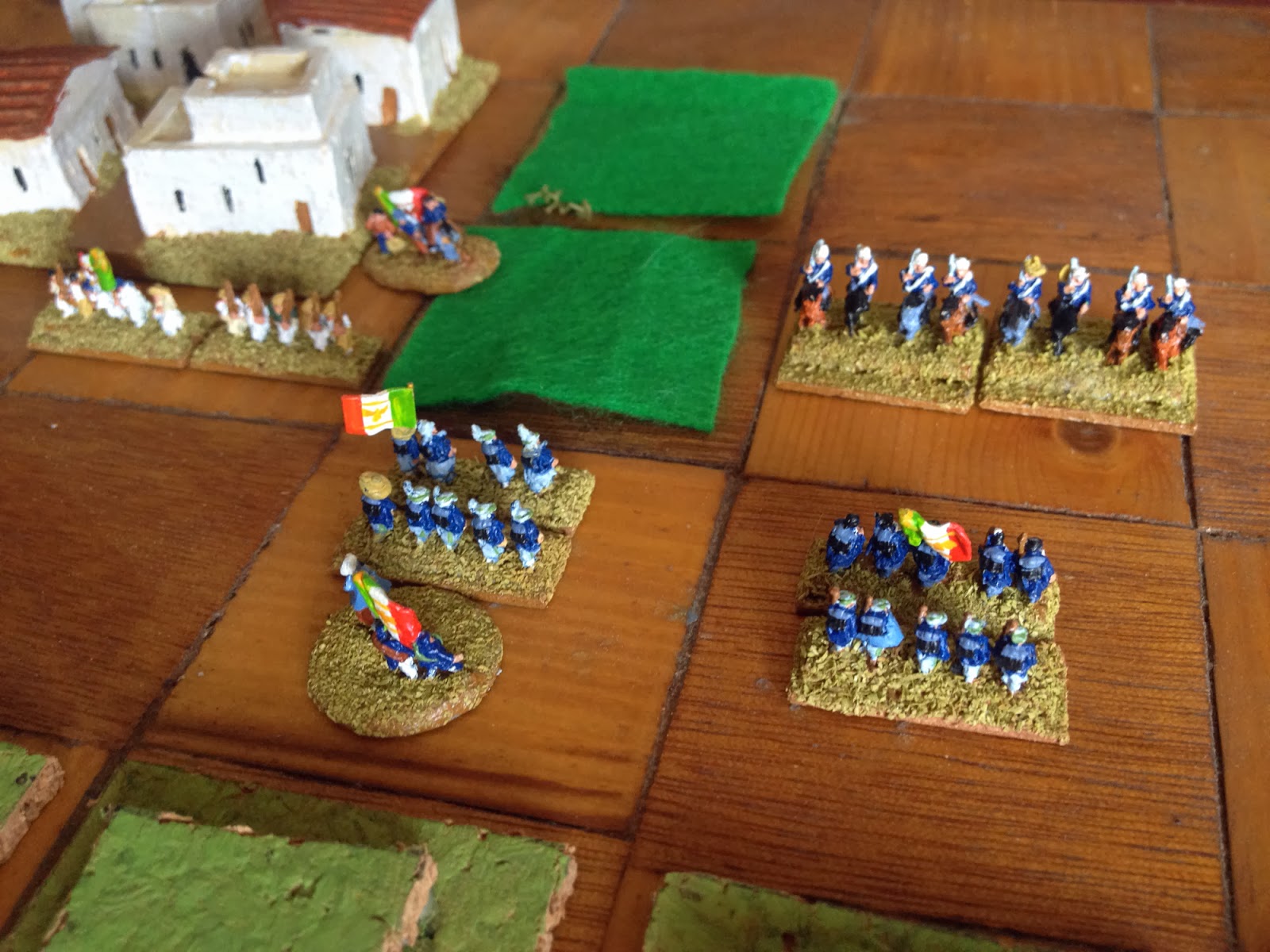Recently I have been following various posts on Warwell's Wargames, especially the Francesian battle reports. These are 19th century square grid games, using the C&C/Battle Cry system, with a few adjustments. I felt inspired to give the rules a try this afternoon, so set up another game based during the Mexican Adventure.
The gist of the rules would be lifted from Battle Cry. But I used ordinary D6, and just translated the scores.
Because of the small size of the play are I reduced movement and ranges. Infantry could move one square and battle. Artillery could move one square or battle. Cavalry and generals could move two squares, and cavalry could battle. If a general was attached to a unit he could automatically move with it.
Ranges were adjacent for cavalry (with 3 dice), two squares for infantry (4 and 2 dice) and three squares for artillery (4, 3 and 2 dice). Infantry could take four hits, cavalry and artillery three hits.
Combat was the same as Battle Cry - a 1 or 2 scored a hit on infantry, a 3 a hit on cavalry and a 4 a hit on artillery. A 5 caused a one square retreat and a 6 scored a hit on anything (including a general).
I used the Warwell activation system, including some adjustments he's been trying. Each army was allowed to roll so many dice per turn (I used three for each side). The scores dictated what type of unit could be activated - 1 or 2 an infantry unit, 3 a cavalry unit, 4 an artillery unit and 6 any unit of the player's choice. On a 5 I allowed the activation of any unit to which a general was attached or the player could add one extra square to the move of an activated unit (but it could no longer battle, even if allowed).
The setup was simple - a Republican force of four infantry units, a cavalry unit and an artillery unit were defending a town. An Imperial/Austrian column was attacking them, consisting of six infantry units, two cavalry and two artillery. I set victory as five flags. The Imperials gained a flag if they could control two squares of the town.
This is the Republican setup. On the left an infantry unit garrisoned an outlying farm.
The Imperials marched on the outlying farm.
Their main force started across the line of hills.
The Republicans had shifted another unit across to support the farm, but took the first hit as the Imperials advanced.
A close assault was less successful.
Retaliation saw the Imperials forced back with heavy casualties.
The Imperial artillery slowly moved up to support the attack.
The Imperials attacked from the woods to the left of the farm, and destroyed the defenders ...
... but the supporting Republicans took their revenge with exceptionally accurate fire, wiping out the attacking Imperials.
With the attack on the farm totally stopped, the main Imperial fore advanced. They had lost two infantry units already, as well as one of the artillery units, destroyed by counter-battery fire from the Republican artillery.
The Imperials advanced on the town, and the Republican cavalry came up in support.
A brisk engagement saw then driven back, but not before they had inflicted casualties on the attackers. By now I'm sure you will have realised that I used small stones to mark hits.
The Republicans had also re-garrisoned the farm. With the battle slipping from their grasp the Imperials resorted to desperate measures, and threw in their cavalry. This was less desperate than it looked here, as the Republican unit had already taken three hits from artillery fire as it advanced, so was close to being destroyed.
Imperial cavalry supported the attack on the town ...
... but a volley from the defenders emptied so many saddles that they routed. This was the fifth unit to be lost, so the Imperials puled out.
An aerial view of the battlefield at the end of the game. The Republicans lost one unit.
The activation worked well, and made for some interesting decisions, although unlike the card/sector-driven activation of Battle Cry it is easier to pick on vulnerable enemy units when you have more choice as to which (say) infantry you are going to activate. Movement, ranges and fire-factors seemed OK just for this game, but I shall see how they stand up to further play. In addition I'd like a way of differentiating troop quality - haven't got any solid ideas on that yet.
A couple of random shots to finish with - here's some Imperial infantry.
And here's the town and its heroic defenders.



















Its pretty easy to make elite, or militia units, give them better, or worse firepower (roll more or less dice or hit with more or less numbers) and/or give them more or fewer hit points. For exceptionally elite forces, the French Old Guard for example, give even more hit points. If Infantry get four, give militia three, or maybe even two, and give grenadiers five and guard six. Rationale, what makes an elite unit better? More staying power and better fire control. You can also play with how often they retreat when regular infantry would maybe there is a chance or a 100% probability the guards and elites won't. "The old guard dies but does not surrender" Waterloo comment attributed to the old guard commander. I understand actualy he said when asked to surrender "Merde" which is French for "Shit". Like General McAuliffe at Bastonge, who said "Nuts". Elite formations vary over time but their commanders have certain similarities.
ReplyDelete